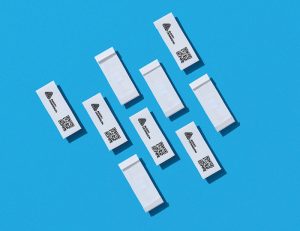
Textile World recently interviewed Avery Dennison’s Michael Colarossi about RFID technologies and their potential to assist in garment recycling.
TW Special Report
Avery Dennison Corp., Mentor, Ohio, is a materials science and digital identification solutions company. It is a global operation with approximately 35,000 employees in more than 50 countries.The company’s products include labels and functional materials, radio-frequency identification (RFID) inlays and tags, software applications, and a variety of brand-enhancing packaging and display information. According to Avery Dennison, its products are used to optimize labor and supply chain efficiency; reduce waste; advance sustainability, circularity and transparency; and better connect brands and consumers. The company operates different divisions serving a variety of industries including its $2 billion Apparel Solutions division.
Recently, Textile World had the opportunity to talk to Michael Colarossi, Avery Dennison’s vice president of Innovation, Product Line Management and Sustainability, about the potential role of RFID technologies in textile recycling. Avery Dennison sees the tags as a potential game changer when it comes to identifying the fiber content of end-of-life apparel so it can be sorted and recycled. Colarossi leads a global technical innovation team that is focused on creating products and solutions in labeling and functional materials, RFID inlays and tags, software applications that connect the physical and digital, and data-driven solutions enhancing the customer experience while promoting circular business models. Prior to his position at Avery Dennison, Colarossi worked for the Netherlands-based AkzoNobel for 15 years in manufacturing and engineering roles. He holds a B.S. in Chemical Engineering, as well as an M.B.A.
TW: You mentioned that Avery Dennison envisions a future where every consumer-facing good will be assigned a unique digital ID. Can you explain more about that?
Colarossi: There is no end in sight for the trend of digitization. In line with that trend, at Avery Dennison, we believe that every physical item will eventually have a unique digital ID assigned to it, connecting the physical and digital worlds. Through that connection, we are seeking to solve our clients’ biggest challenges, including supply chain efficiency and waste, transparency and circularity, and connectivity between brands and consumers. It’s why we continue to invest in physical sensor technologies like RFID and have built a connected product cloud called atma.io.
TW: Please explain a little about Avery Dennison’s RFID capabilities.
Colarossi: Avery Dennison is the world’s largest producer of ultra-high frequency (UHF) RFID inlays. We have the capability to innovate, design and manufacture new RFID technologies for uses in multiple environments, including apparel, general retail, beauty, grocery and automotive.
TW: How do you see these RFID technologies driving sustainability in the textile and apparel industry? What is the potential?
Colarossi: Efficient sortation is one of the biggest challenges for recyclers. We can store information about a textile’s composition on an RFID chip, and a recycler with an RFID scanner can then immediately identify the composition of a garment and use that data to automatically sort garments. For that to happen, of course, RFID needs to be permanently attached or integrated into a garment. We’ve innovated a solution to do just that, while also ensuring that personal data is secure and not shared.

TW: Are there additional technologies that could be blended with the RFID tags to enhance implementation and successful use in recycling programs?
Colarossi: Yes. In fact, because RFID is not a consumer-facing technology today, pairing RFID with other technologies is important for creating a complete recycling solution. Using a consumer facing digital sensor like a QR code, in conjunction with RFID, brands can commu-nicate care instructions to prolong a garment’s life, suggest resale or second-life options, and provide information on how and where to recycle clothing. And what’s exciting is that we’re already doing it today.
TW: What will it take for the industry to begin implementing these technologies and have them play a role in circularity?
Colarossi: There are likely two paths toward adoption. The first is for brands to recognize the value that adopting digital label technologies can bring to their businesses. Reducing waste, improving inventory visibility, creating post-sale connections with consumers, ensuring authenticity, enhancing the retail experience and establishing item level supply chain transparency all can be enabled through these technologies. The second is mandatory regulations. Pending legislation around the EU digital product passports, extended producer responsibility, and supply chain due diligence are all set to impact the industry.
But, we also need to remember that the technologies alone will not be sufficient. We also need to accelerate investments in collection and sortation infrastructure, and textile-to-textile recycling technologies like Circ, a company into which Avery Dennison has invested and continues to partner.
 TW: How are the RFID tags attached to garments? Are there any downsides or issues that need to be addressed to ensure their longevity and efficacy as a tool for circularity?
TW: How are the RFID tags attached to garments? Are there any downsides or issues that need to be addressed to ensure their longevity and efficacy as a tool for circularity?
Colarossi: Historically, RFID technologies have been integrated into branded hang tags or price tickets and attached to garments via fastener, or they have been integrated into fabric care and content labels and sewn into garments. More recently, Avery Dennison has innovated new technology that allows us to sew RFID directly into a garment. AD TexTrace™ is our solution portfolio of integrated RFID labels for Connected Textiles. They can be sewed in as visible brand labels or invisible inlays in the seam or overlock, meaning they remain in the product during its entire lifecycle.
To enable circularity, RFID technology needs to survive the life of a garment, including all of the wash cycles. And so, Avery Dennison continues to innovate technologies that enhance the durability of RFID inlays to ensure they are functional at a garment’s end of life.
TW: Are there regulation issues that need to be considered or that may impede the process?
Colarossi: I am not aware of any issues. I would actually argue that the current regulatory environment in Europe and the United States makes RFID even more critical.
TW: What intrigues you about RFID technology?
Colarossi: RFID technology adoption in the apparel industry was largely driven by inventory accuracy and visibility. But now that the technology is more widespread, we are starting to see the technology enable new use cases. From enabling self-check-out to enhancing brand protection and authenticity to enabling circularity, I’m excited to see these future use cases take flight.
March/April 2024




